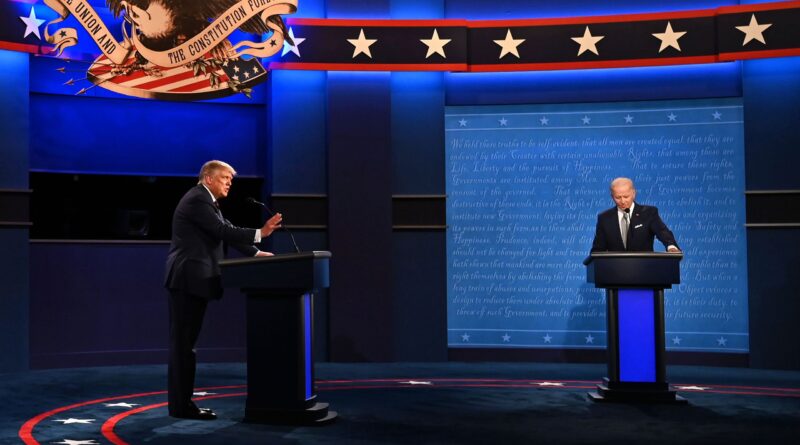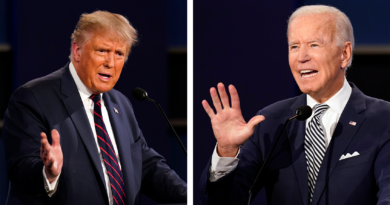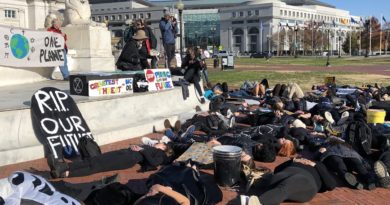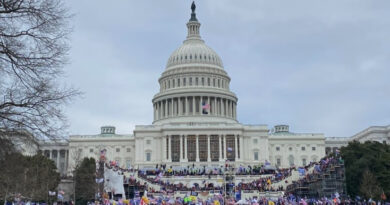Recapping and Fact Checking the Last Presidential Debate of 2020 Pt. 1: Climate Change
ABC political commentator and anchor George Stephanopolous described the Oct. 22 presidential debate in Nashville, Tennessee as involving “two white men in their seventies,” who are “two very different candidates.”
This was also a very different debate from the first one. Debate moderator and NBC White House correspondent Kristen Welker managed to keep the debate civil for the most part, aided by the threat of disobedient candidates having their microphones muted. Instead of being constantly interrupted by the other, each candidate was able to clearly respond to Welker’s questions and outline their positions and policy proposals on key issues.
The Blake Beat polled our readers and we took note of the issues you cared about most: climate change, racism, immigration, and abortion. The candidates did not discuss all these issues in this final debate, but they did discuss the first three. We will publish recaps and fact checks for each individual segment. We will issue a separate article on the candidates’ views on abortion and the COVID-19 crisis at a later date, but before Nov. 3 so those eligible can join the more than 50 million Americans who have made an informed decision in the 2020 presidential election.
First up: Climate change.
CLIMATE CHANGE
TRUMP
President Trump began the discussion on climate change by saying, “We do love the environment…I want crystal clean water and air.” He claimed the United States has the lowest carbon emissions numbers it has seen in the last 35 years; however, the Environmental Protection Agency reported that from 1990-2018, all greenhouse gas emissions have increased at an annual rate of 0.2%, with carbon emissions now comprising 81% of all US greenhouse gas emissions. This percentage is higher than the carbon emissions percentage reported for the last three years.
Trump also said he pulled the United States out of the Paris Climate Accords because staying in the agreement would have cost the United States trillions of dollars. The United States pledged to fund the accords, aimed at reducing greenhouse gas emissions, cutting pollution in general, and bettering the environment as a whole, with $3 billion. However, when Trump pulled the US out of the climate accords in June 2017, the United States had only committed $1 billion. Had the US remained in the accords, they would have ended up committing roughly $2.5 trillion by 2035, which would equate to a total GDP decrease of 0.55% per year, according to FactCheck.org, which is a project operating out of the University of Pennsylvania’s Annenberg Public Policy Center.
Trump also claimed that China and Russia have committed nothing and “barely anything” respectively to the environmental protection funds member states of the climate accords agreed to pledge money to. “Look at China, how filthy it is. Look at Russia, look at India. It’s filthy. I took us out of the [Paris Climate] Accords because it would have cost us trillions…it was so unfair,” Trump said.
While China and Russia did not contribute to the Green Climate Fund in 2017, when the FactCheck article was written, Russia and China did contribute to the Global Environment Facility. Additionally, while the United States did contribute to the Green Climate Fund, they were eleventh on the list of member states in terms of how much they pledged per capita. Also, per capita, the US emitted more greenhouse gases than India and China combined in 2015. While those figures may have changed in the last five years, they were still accurate at the time Trump initially began making these claims in 2017.
President Trump also claimed the US is energy independent, which is misleading. The Washington Post reported in early January, when there was concern that potential conflict with Iran could negatively impact oil prices for US consumers, that the US is less sensitive to economic shocks to oil than in past years, but is still very vulnerable to increases in oil prices. The Washington Post reports that the US could become a net exporter of oil, but is still far from energy independent.
He also attacked former Vice President Joe Biden’s support of means of renewable energy—critiquing wind turbines, which he called windmills, especially. He says wind turbines lower the value of homes and kill birds, and that the manufacturing of wind turbines generates more carbon emissions than wind turbines would reduce, which is simply false, according to the National Renewable Energy Laboratory.
President Trump directly called out Representative Alexandria Ocasio-Cortez (D-NY), and referenced her colleagues, Representatives Ilhan Omar (D-MN), Rashida Tlaib (D-MI), and Ayanna Pressley (D-MA), in his criticism of Rep. Ocasio-Cortez’s Green New Deal. “AOC Plus Three knows nothing about the climate,” Trump said. “This is the craziest thing our country has ever seen. This wasn’t done by smart people.”
By “smart people,” it can be assumed Trump was referring to scientists. It would appear that the scientific community has not widely supported the Green New Deal, but that the overall idea of the bill was informed/inspired by the Intergovernmental Panel on Climate Change.
Trump also claimed that the Green New Deal would cost America $100 trillion, but FactCheck said that figure is misleading. The highest estimate comes from a center-right think tank, which predicts the Green New Deal would cost the public $93 trillion, but FactCheck says it is difficult to come up with an accurate estimate of the Green New Deal’s cost when so many of the policies listed in the bill are simply ideas.
According to Senator Bernie Sanders (I-VT), who listed his own interpretation of the Green New Deal on his campaign website, the aim of the Green New Deal would be to end unemployment by creating new jobs devoted to transitioning the country to 100% renewable energy, declare climate change a national emergency, make homes energy efficient, make public transportation more robust, provide grants to families to purchase electric vehicles, rejoin the Paris Climate Accords, and much more. Sanders does not list monetary values for all of these proposed initiatives, but says $16.3 trillion would be invested in domestic efforts and $200 billion would be given to the Green Climate Fund. Sanders claims that this investment will pay for itself as we would lose much more by withstanding the negative effects of climate change.
BIDEN
Former Vice President Joe Biden has come out making strong policy statements on climate change. “Climate change is an existential threat to humanity,” Biden said. “We have a moral obligation to deal with it. We’ve been told by all the leading scientists that we are running out of time.”
Biden claimed that the world will reach a so-called “point of no return” within eight years. The “point of no return” can generally be summarized as the point at which the world will no longer be able to reverse the negative effects of climate change. We will not be able to slow or stop the melting of glaciers, more animals will be pushed to extinction, the Earth will become hotter, weather will become even more volatile, etc. This “point of no return” will be reached when the world has warmed 2 degrees Celsius since before the Industrial Revolution. According to the Yale Environment Review, if a substantial number of countries adopted moderate tactics to reduce greenhouse gas emissions and remove greenhouse gases from the atmosphere, the “point of no return” will be reached by 2035. Some have established a “point of no return” as the Earth being 1.5 degrees Celsius warmer than it was in the days before the Industrial Revolution, and in that case, we have already reached the “point of no return.”
Biden pledged to invest in 50,000 electric car charging stations on America’s highways, aiming to “own” the electric car industry. Adopting elements from the Green New Deal, Biden committed to creating more jobs to retrofit homes, making them more energy efficient, therefore bolstering the US economy. “The whole idea is that this is going to create millions of jobs,” Biden said. “Our health and our lives are [at] stake.”
Erroneously, when refuting Trump’s claims about the lack of scientific support for the Green New Deal, Biden said the bill was backed by every major environmental group and every labor group. Though select environmental groups and labor groups have supported the Green New Deal, this broad blanket claim cannot be substantiated. Biden also falsely claimed that the fastest-growing industries in the US were solar and wind energy production, but those would appear to be healthcare and social services according to the US Bureau of Labor Statistics.
Most contentious from the climate change portion of the debate was Biden’s stance on fracking. Trump claimed Biden wanted to ban fracking outright and ruin the oil industry, and that he was misleading voters from key oil-producing states. However, Biden has said that he wants to ban only new gas and oil production projects on federal land. He acknowledges that in order to get the United States to net zero carbon emissions, the federal government would need to slowly phase fracking out and transition it to renewable energy. Along those lines, Biden vowed to end federal subsidies to the oil industry.




